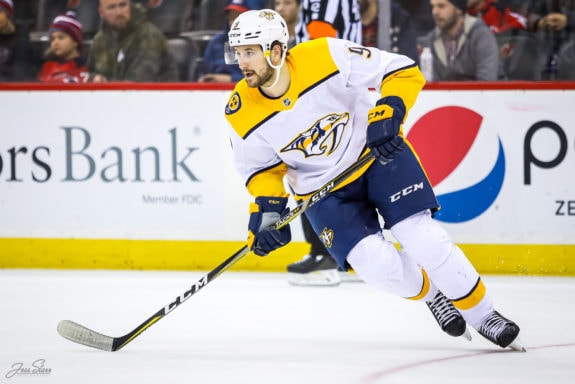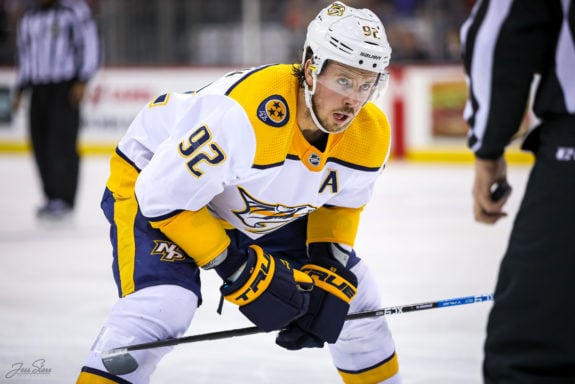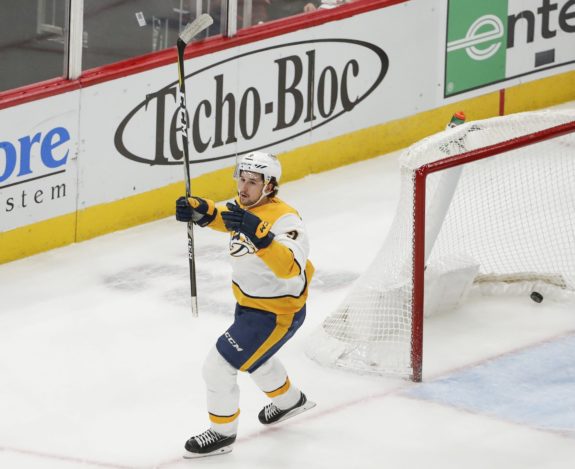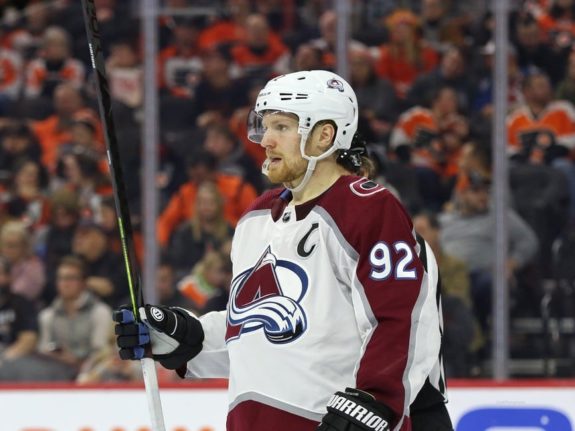If Filip Forsberg is ever inducted into the Hockey Hall of Fame, Nashville Predators general manager David Poile will have one heck of a story to dine out on. Bringing the young Swedish forward to Nashville was a very lucrative, very one-sided trade, remembered with great fondness by fans. It will be featured in every “Most Lopsided Trades in NHL History” article from now until perhaps the end of time. It’s also why Poile perhaps has a longer leash than some believe he deserves.
However, it’s a dangerous game to utter those three words about a young player: Hall of Fame. No one knows how the rest of Forsberg’s career will play out. We know how it’s going. We can predict how it may go. But as they say, there are only two certainties in life: death and taxes. We also know that Forsberg is 27 years old, enjoying a fine career, is one of the Predators’ best players – perhaps their best forward – and he is going to need a new contract soon.
For the record, and maybe to avoid any unnecessary panic, Forsberg still has one year left on his current deal. If an extension doesn’t come before the start of the upcoming season, it’s not a big deal. However, the day will come when a new contract will need to be negotiated – assuming the Predators want to re-sign Forsberg, which seems like a no-brainer – but the team may have little to no leverage when those talks get underway and from a management standpoint that could be a problem.

You cannot accuse Poile of not valuing winning. His actions are proof. He’s kept the team’s core mainly intact. When many thought the Predators would trade Forsberg during the lows of last season, Poile stayed committed because he knows the team is far better with the talented forward than without him. The GM believes they have the pieces to win. He would rather fight every season than tear it apart, forage draft picks and sink to the bottom of the standings to increase the value of their picks.
But the Predators already have two forwards taking up $16 million of cap space, in Matt Duchene and Ryan Johansen. Nashville will have to pay Forsberg, and given the market, he may warrant between $7 million and $8 million in average annual value (AAV). So, the team could have around $24 million tied up in three forwards, two of which have not exactly delivered to the expected standard.
The Salary Cap’s Slow Climb
According to Frank Seravalli, the cap for the 2022-23 season is expected to rise, which would be the first season of Forsberg’s new deal. However, the bump isn’t dramatic: “a rise to $82.5 million in 2022-23 would likely trigger the start of a ‘lag formula,’ as agreed upon in Collective Bargaining Agreement negotiations between the NHL and NHL Players’ Association in 2020, that could see the salary cap climb $1 million each offseason until the escrow balance owed to owners is paid off,” Seravalli reports.
Related: 5 Takeaways from Nashville Predators Development Camp
The Predators’ potential top earners at the forward position could make up 29% of the team’s entire cap! It doesn’t leave a whole lot of room for building quality depth. This may not even be speculation. You can see the effects of paying less than a handful of players a big chunk of the cap with the Toronto Maple Leafs and the Edmonton Oilers. Not a whole lot of playoff success between those two franchises as of late.

The obvious solutions may be to either decide that they cannot afford Forsberg and see what value he can fetch on the market, where there will be plenty of suitors, or try and convince him to take less money to stay with the team. Both options are valid, but neither one is great.
Forsberg is arguably one of, if not the best forward the Predators have ever had. Paul Kariya could have held the title, but he only suited up for two seasons in the Music City. Over the past five seasons, the man marveled for his mustache is second in team scoring. He trails only Roman Josi, who’s an otherworldly talent.
However, when you’re trying to make the argument that Forsberg is the best forward in franchise history, anything but first may dampen the potency of the point. But consider this, Forsberg has played in 31 fewer games than the captain yet has just four points less over that five-year span.
As for goal scoring, it’s a similar story. Since 2016-17, Forsberg has had the second most team goals, with only the recently departed Viktor Arvidsson amassing more. But again, Forsberg, despite playing in eight fewer games than his fellow countryman trails by just one goal.

If you take the timeframe back one more season, so from 2015-16 to present, then Forsberg is the team leader, by a lot. Over the past six seasons, he’s tallied 151 goals. Arvidsson currently sits in the second spot. In the nature of transparency and fairness, he’s played fewer games than Forsberg over that timespan in question. But you could spot Arvidsson a goal per game until the games played were equal, and he still wouldn’t have as many goals as Forsberg.
Related: 3 Predators Who Need to Step Up in 2021-22
He’s second on the franchise’s all-time goals list – just 32 behind longtime Predator David Legwand – and he’s still only 27. Among players who have skated in 100 or more games for the Predators, Forsberg is fourth in points per game. The accolades go on and on. The Predators have long struggled with offense; it’s no secret. So, it may go without saying that he’s not the type of talent that the team can afford to let go of. If they did decide to part ways, it would be a serious step backward, something that the front office doesn’t view favorably. Trading him could fetch some pretty valuable assets, but the return would have to be young, less than fully polished prospects. Acquiring someone of similar talent and who’s equipped to help the team win now would command just as much salary, putting the Predators back in the same predicament of having a high salary concentration among just three forwards.
Keeping Harmony In The Locker Room
So, onto trying to convince Forsberg to take a little bit of a discount. Well, this is where it could get a little messy.
Each player should be judged based on their sole abilities and accomplishments when negotiating their next contract. However, that’s not how sports tend to work. The market dictates value. Gabriel Landeskog recently put pen to paper and signed an eight-year, $56 million deal back in July, which gives him an AAV of $7 million. Well, Forsberg is performing just as well as the Colorado Avalanche captain. Over the past five seasons, both players are operating at 0.80 points per game, both have similar stats on the power play and the two Swedes log roughly the same amount of ice time. The only major difference is that Forsberg is doing all this without Nathan Mackinnon, so it may be fair to give the tiebreaker to the Predators’ star.

But there’s also quite the lucrative market sitting right in Forsberg’s own locker room. At this point, it feels like piling on, but we have to bring up Duchene and Johansen once more. A $7 million AAV seems fair, but he’s by far outperforming two players on his own team that are drawing in AAVs of $8 million. Some could argue that teammates should have nothing to do with an individual’s own contract. However, can you imagine how awkward it will be to walk into the building every day and see two guys who are producing much less, but are cashing bigger cheques?
Not only is it awkward, but it could also verge on the side of resentment. You don’t need to be a professional athlete to know something like that can divide and tear a locker room apart eventually.
Poile has given out too many bad deals during his time in Nashville, some of which are still felt to this day. Remember, they are still feeling the impact of Kyle Turris. But even though these experiences may have the GM second-guessing his every decision now, he shouldn’t have to think very long about handing out Forsberg’s next deal. Mainly because the difficult negotiating part may already be out of his hands. It should be just a matter of opening the cheque book and signing on the dotted line.